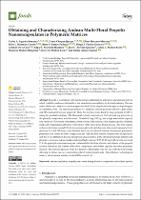| dc.contributor.author | Ligarda Samanez, Carlos A. | es_PE |
| dc.contributor.author | Choque Quispe, David | es_PE |
| dc.contributor.author | Moscoso Moscoso, Elibet | es_PE |
| dc.contributor.author | Huamán Carrión, Mary L. | es_PE |
| dc.contributor.author | Ramos Pacheco, Betsy S. | es_PE |
| dc.contributor.author | Peralta Guevara, Diego E. | es_PE |
| dc.contributor.author | De la Cruz, German | es_PE |
| dc.contributor.author | Martínez Huamá, Edgar Luis | es_PE |
| dc.contributor.author | Arévalo Quijano, José C. | es_PE |
| dc.contributor.author | Muñoz Saenz, Jenny C. | es_PE |
| dc.contributor.author | Muñoz Melgarejo, Mauricio | es_PE |
| dc.contributor.author | Aroni Huamán, Jimmy | es_PE |
| dc.date.accessioned | 2023-04-19T17:58:54Z | |
| dc.date.available | 2023-04-19T17:58:54Z | |
| dc.date.issued | 2022 | |
| dc.identifier.uri | https://hdl.handle.net/20.500.14168/769 | |
| dc.description.abstract | Propolis is a substance with significant anti-inflammatory, anticancer, and antiviral activity,
which could be used more efficiently at the nano level as an additive in the food industry. The aim
was to obtain and characterize nanoencapsulated multi-floral propolis from the agro-ecological region
of Apurimac, Peru. For nanoencapsulation, 5% ethanolic extracts propolis with 0.3% gum arabic
and 30% maltodextrin were prepared. Then, the mixtures were dried by nano spraying at 120 ◦C
using the smallest nebulizer. The flavonoid content was between 1.81 and 6.66 mg quercetin/g,
the phenolic compounds were between 1.76 and 6.13 mg GAE/g, and a high antioxidant capacity
was observed. The results of moisture, water activity, bulk density, color, hygroscopicity, solubility,
yield, and encapsulation efficiency were typical of the nano spray drying process. The total organic
carbon content was around 24%, heterogeneous spherical particles were observed at nanometer level
(between 11.1 and 562.6 nm), with different behaviors in colloidal solution, the thermal gravimetric
properties were similar in all the encapsulates, the FTIR and EDS analysis confirmed the encapsulation
and the X-ray diffraction showed amorphous characteristics in the obtained material; stability and
phenolic compound release studies indicated high values of 8.25–12.50 mg GAE/g between 8 and
12 h, the principal component analysis confirmed that the flora, altitude, and climate of the propolis
location influenced the content of bioactive compounds, antioxidant capacity, and other properties
studied. The nanoencapsulate from the district of Huancaray was the one with the best results,
allowing its future use as a natural ingredient in functional foods. Nevertheless, technological,
sensory, and economic studies should still be carried out. | es_PE |
| dc.format | application/pdf | es_PE |
| dc.language.iso | eng | es_PE |
| dc.publisher | MDPI Journal List | es_PE |
| dc.rights | info:eu-repo/semantics/openAccess | es_PE |
| dc.rights | Attribution-NonCommercial-NoDerivatives 4.0 Internacional | * |
| dc.rights.uri | info:eu-repo/semantics/openAccess | es_PE |
| dc.rights.uri | http://creativecommons.org/licenses/by-nc-nd/4.0/ | * |
| dc.subject | nanoencapsulation; propolis; nano spray drying; bioactive compounds; antioxidant capacity | es_PE |
| dc.title | Obtaining and Characterizing Andean Multi-Floral Propolis Nanoencapsulates in Polymeric Matrices | es_PE |
| dc.type | info:eu-repo/semantics/article | es_PE |
| dc.type.version | info:eu-repo/semantics/publishedVersion | es_PE |
| dc.publisher.country | CH | es_PE |
| dc.subject.ocde | http://purl.org/pe-repo/ocde/ford#1.04.04 | es_PE |
| dc.identifier.doi | https://doi.org/10.3390/foods11203153 | es_PE |


